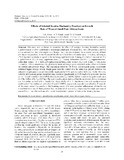| dc.contributor.author | Korir, B.K | |
| dc.contributor.author | Kinuthia, R.N | |
| dc.contributor.author | Nyariki, D.M | |
| dc.date.accessioned | 2013-07-19T08:58:37Z | |
| dc.date.available | 2013-07-19T08:58:37Z | |
| dc.date.issued | 2010 | |
| dc.identifier.citation | B.K. Korir, R.N. Kinuthia and D.M. Nyariki, 2010. Effects of Selected Routine Husbandry Practices on Growth Rate of Weaned Small East African Goats. Research Journal of Animal Sciences, 4: 66-71. | en |
| dc.identifier.uri | http://www.medwelljournals.com/abstract/?doi=rjnasci.2010.66.71 | |
| dc.identifier.uri | http://erepository.uonbi.ac.ke:8080/xmlui/handle/123456789/49325 | |
| dc.description.abstract | This study was conducted to determine the effects of overnight housing, helminthes control, supplementation and their combinations on average weight gain of weaned Small East African Goats (SEAG) in the semi-arid southeastern rangelands of Kenya. The study also evaluated the economic viability of these goat husbandry practices. About 40 weaned Small East African Goats of similar age (7±1 months) and weights (21±3 kg) were randomly assigned to the following eight treatments: housing (Th); helminthes control (Td); supplementation (Ts); housing+supplementation (Ths); housing+helminthes control (Thd); supplementation+ helminthes control (Tsd); housing+supplementation+helminthes control (Thsd) and control (Tc-traditional husbandry). All the animals were weighed every week and weight gains calculated as the difference between the current and previous weight. The experiment lasted for 18 weeks. All treatment groups consistently exhibited higher average weekly weight gains than the control over the entire trial period. However, the enhanced weight gains were not statistically significant (p<0.05) up to the end of 3rd week. On the 4th week, however all treatment groups except housing, registered significantly (p<0.05) higher weight gains than the control. Overall a combination of all the three treatments (Thsd) had the highest impact on the goats weight gain (6.95 kg) followed by Tsd (6.65 kg). The cost-benefit analysis indicated that the most cost-effective treatment was helminthes control with a Benefit-Cost Ratio (BCR) of 9.45. Supplementation and supplementation combined with helminthes control with 2.35 and 2.75 RBCs, respectively were also cost-effective. The results of this study support the conclusion that housing; control of internal parasites; enhancement of nutrition or a combination of any of these practices has the potential of substantially improving the weight gain rate of weaned Small East African Goats which would translate into increased off-take and ultimately, income | en |
| dc.language.iso | en | en |
| dc.publisher | University of Nairobi, | en |
| dc.title | Effects of Selected Routine Husbandry Practices on Growth Rate of Weaned Small East African Goats | en |
| dc.type | Article | en |
| local.publisher | college of agriculture and vetenary services | en |

